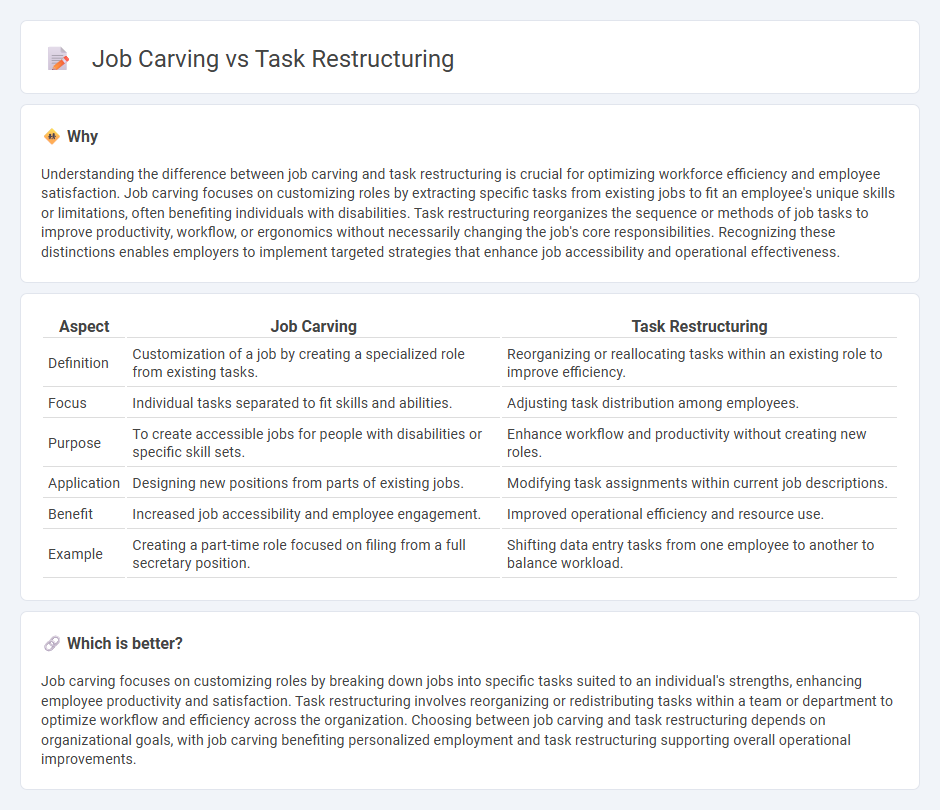
Job carving focuses on customizing job roles by extracting specific tasks from existing positions to match individual skills, thereby enhancing workforce inclusion and productivity. Task restructuring reorganizes work processes and responsibilities within a job or team to improve efficiency, adapt to changing demands, and support employee strengths. Explore how job carving and task restructuring can transform employment strategies for better workforce engagement and operational success.
Why it is important
Understanding the difference between job carving and task restructuring is crucial for optimizing workforce efficiency and employee satisfaction. Job carving focuses on customizing roles by extracting specific tasks from existing jobs to fit an employee's unique skills or limitations, often benefiting individuals with disabilities. Task restructuring reorganizes the sequence or methods of job tasks to improve productivity, workflow, or ergonomics without necessarily changing the job's core responsibilities. Recognizing these distinctions enables employers to implement targeted strategies that enhance job accessibility and operational effectiveness.
Comparison Table
| Aspect | Job Carving | Task Restructuring |
|---|---|---|
| Definition | Customization of a job by creating a specialized role from existing tasks. | Reorganizing or reallocating tasks within an existing role to improve efficiency. |
| Focus | Individual tasks separated to fit skills and abilities. | Adjusting task distribution among employees. |
| Purpose | To create accessible jobs for people with disabilities or specific skill sets. | Enhance workflow and productivity without creating new roles. |
| Application | Designing new positions from parts of existing jobs. | Modifying task assignments within current job descriptions. |
| Benefit | Increased job accessibility and employee engagement. | Improved operational efficiency and resource use. |
| Example | Creating a part-time role focused on filing from a full secretary position. | Shifting data entry tasks from one employee to another to balance workload. |
Which is better?
Job carving focuses on customizing roles by breaking down jobs into specific tasks suited to an individual's strengths, enhancing employee productivity and satisfaction. Task restructuring involves reorganizing or redistributing tasks within a team or department to optimize workflow and efficiency across the organization. Choosing between job carving and task restructuring depends on organizational goals, with job carving benefiting personalized employment and task restructuring supporting overall operational improvements.
Connection
Job carving and task restructuring both focus on customizing work roles to improve employee fit and productivity by breaking down standard job descriptions into specific, manageable tasks. Job carving identifies unique job duties that match an individual's skills, often to accommodate people with disabilities, while task restructuring reorganizes existing processes to streamline workflows and enhance efficiency. These strategies are interconnected as they both promote tailored employment solutions, increasing job satisfaction and retention.
Key Terms
Task Redistribution
Task restructuring involves reorganizing existing job roles by reallocating tasks to enhance efficiency and employee satisfaction. Job carving specifically extracts specific duties from a job to create new, tailored positions that align with individual skills or organizational needs. Explore how these strategies redefine workforce productivity and optimize role allocation.
Individualization
Task restructuring involves modifying existing roles by redistributing responsibilities across multiple tasks to improve efficiency and fit individual strengths, whereas job carving specifically extracts certain duties from a job to create a customized position tailored to an individual's unique skills and needs. Both strategies aim to enhance employee performance and satisfaction by aligning work assignments with personal abilities, promoting inclusion and productivity. Explore how these approaches can optimize workforce management and support diverse talent development.
Essential Functions
Task restructuring involves modifying job duties to better align with an employee's capabilities while preserving the core responsibilities integral to the position. Job carving specifically extracts essential functions from existing roles to create tailored job descriptions that accommodate individual strengths and limitations, often facilitating workplace inclusion. Explore how task restructuring and job carving enhance workforce diversity by focusing on essential functions in employment practices.
Source and External Links
What is job restructuring and how to do it? - Testlify - Job restructuring involves adjusting roles, tasks, or responsibilities to improve efficiency and meet business goals, typically through a strategic multi-step process including assessment, planning, stakeholder engagement, implementation, and evaluation.
What Is Job Restructuring + Tips for Change Management - TestGorilla - Job restructuring means changing job duties, responsibilities, or setup to better align with business or employee needs, using strategies like task changes, schedule changes, role combining, or job sharing, guided by analysis of business demands and clear planning.
Job Restructuring: What It Is And How to Do It Right? - Fuel50 - Job restructuring is a strategic process where jobs are altered by adding or removing responsibilities, following steps of identifying need, determining scope, planning, implementing, and evaluating impact on business goals and employee engagement.
 dowidth.com
dowidth.com